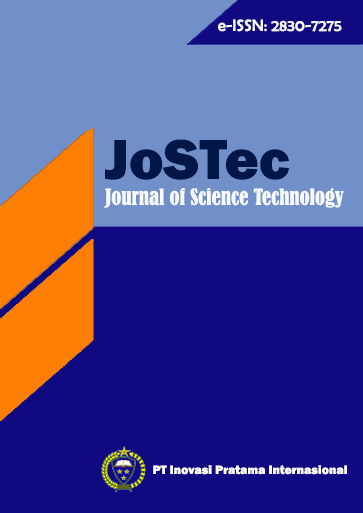Performance Tests of Cessna 172S Magnetos Under Various Thermal Conditions
DOI:
https://doi.org/10.55299/jostec.v5i1.628Keywords:
Magneto, Permanent magnet, Engine starting, Cessna 172S, Lycoming engineAbstract
Magneto serves as the ignition source in the combustion process of piston aircraft engines. Typically, spark-ignition aircraft like the Cessna 172SP are equipped with two ignition systems (dual magnetos). Dual magnetos are installed so that if one system fails, the aircraft can still continue its flight. During the engine startup process, the magneto plays a significant role as the ignition source for the initial combustion before the aircraft engine comes to life. In the case experienced by pilots at the Indonesian Civil Pilot Academy Banyuwangi, starting the engine became challenging when the aircraft had been previously used for a flight. Therefore, this research is conducted to address the underlying causes of this issue. The parameters examined in this research include outside air temperature (OAT), Cylinder Head Temperature (CHT), and Exhaust Gas Temperature (EGT). Data were collected regarding the duration of the engine startup process. The duration time for starting the engine was found to be the highest at an exhaust gas temperature of 135 °F, a cylinder head temperature of 180 °F, and an outside air temperature of 35 °F, with a duration time of 6.8 seconds. Conversely, the shortest engine startup duration was observed at an exhaust gas temperature of 75 °F, a cylinder head temperature of 75 °F, and an outside air temperature of 26 °F, resulting in a duration time of 1.6 seconds.
Downloads
References
Czarnigowski, J., & Jakliński, P. (2019). The influence of the ignition control on the performance of an aircraft radial piston engine. Combustion Engines, 177(2), 60–65. https://doi.org/10.19206/CE-2019-211
Finkelberg, L., Kostuchenkov, A., Zelentsov, A., & Minin, V. (2019). Improvement of Combustion Process of Spark-Ignited Aviation Wankel Engine. Energies, 12(12), 2292. https://doi.org/10.3390/en12122292
Gauyacq, J.-P., Lorente, N., & Novaes, F. D. (2012). Excitation of local magnetic moments by tunneling electrons. Progress in Surface Science, 87(5–8), 63–107. https://doi.org/10.1016/j.progsurf.2012.05.003
Jerlăianu, M., Petrişor, S. M., & Bouleanu, I. (2020). Aspects Regarding the Practical Realization of an Electric Generator with an Adapted Magneto as an Energy Source. International Conference KNOWLEDGE-BASED ORGANIZATION, 26(3), 114–119. https://doi.org/10.2478/kbo-2020-0124
Kruiver, P. P., Dekkers, M. J., & Heslop, D. (2001). Quantification of magnetic coercivity components by the analysis of acquisition curves of isothermal remanent magnetisation. Earth and Planetary Science Letters, 189(3–4), 269–276. https://doi.org/10.1016/S0012-821X(01)00367-3
Lee, K., Kim, W., Jin, C., & Lee, J. (2015). Local demagnetisation analysis of a permanent magnet motor. IET Electric Power Applications, 9(3), 280–286. https://doi.org/10.1049/iet-epa.2014.0244
Li, J., Tang, X., Sepehri-Amin, H., Ohkubo, T., Hioki, K., Hattori, A., & Hono, K. (2020). On the temperature-dependent coercivities of anisotropic Nd-Fe-B magnet. Acta Materialia, 199, 288–296. https://doi.org/10.1016/j.actamat.2020.08.040
Luo, H., Zhang, Y., Wang, H., Liang, B., & Zhang, F. (2022). Analysis of multi-field coupled air friction loss and temperature field of high-speed permanent magnet machine. Energy Reports, 8, 118–124. https://doi.org/10.1016/j.egyr.2022.02.172
Mcclelland, R. P. (1971, February 1). Development of a Dual Ignition System for General Aircraft. https://doi.org/10.4271/710382
Mirza, A. K., Ballard, S. P., Dance, S. L., Maisey, P., Rooney, G. G., & Stone, E. K. (2016). Comparison of aircraft‐derived observations with in situ research aircraft measurements. Quarterly Journal of the Royal Meteorological Society, 142(701), 2949–2967. https://doi.org/10.1002/qj.2864
Mohammadi, R., Mozaffar, A., Mardaneh, M., & Darabi, A. (2014). A review of thermal analysis methods in electromagnetic devices. 2014 IEEE 23rd International Symposium on Industrial Electronics (ISIE), 739–744. https://doi.org/10.1109/ISIE.2014.6864704
Sulung, S. D., Rumani, D. D., Qiram, I., Nasrullah, M. N. C. H., & Wibowo, U. L. N. (2023). Impact of the fuel mixture ratio of AVGAS 100LL and RON 92 fuel on combustion characteristics. Journal of Science Technology (JoSTec), 5(1), 07–13. https://doi.org/10.55299/jostec.v5i1.478
Wild, T. W. (2018). Aircraft Powerplants (9th Edition). McGraw-Hill Education. https://www.accessengineeringlibrary.com/content/book/9781259835704
Wrobel, R., Mellor, P., Popescu, M., & Staton, D. (2015). Power Loss Analysis in Thermal Design of Permanent Magnet Machines – A Review. IEEE Transactions on Industry Applications, 2015, 1–1. https://doi.org/10.1109/TIA.2015.2489599
Wrobel, R., Staton, D., Lock, R., Booker, J., & Drury, D. (2015). Winding Design for Minimum Power Loss and Low-Cost Manufacture in Application to Fixed-Speed PM Generator. IEEE Transactions on Industry Applications, 51(5), 3773–3782. https://doi.org/10.1109/TIA.2015.2434802
Xiaogang, W., Bolan, L., Xiyang, Y., Chao, Y., Fei, Y., & Zhenfeng, Z. (2020). Study on Fuel and Injection Influence on a Spark Ignition Aeropiston Engine. Journal of Engineering for Gas Turbines and Power, 142(7). https://doi.org/10.1115/1.4047282
Yu, L., Wu, H., Zhao, W., Qian, Y., Zhu, L., & Lu, X. (2021). Experimental study on the application of n-butanol and n-butanol/kerosene blends as fuel for spark ignition aviation piston engine. Fuel, 304. https://doi.org/10.1016/j.fuel.2021.121362
Downloads
Published
How to Cite
Issue
Section
License
Copyright (c) 2023 Muhammad Nur Cahyo Hidayat Nasrullah, Sabam Danny Sulung, Untung Lestari Nur Wibowo, Ikhwanul Qiram

This work is licensed under a Creative Commons Attribution 4.0 International License.


















